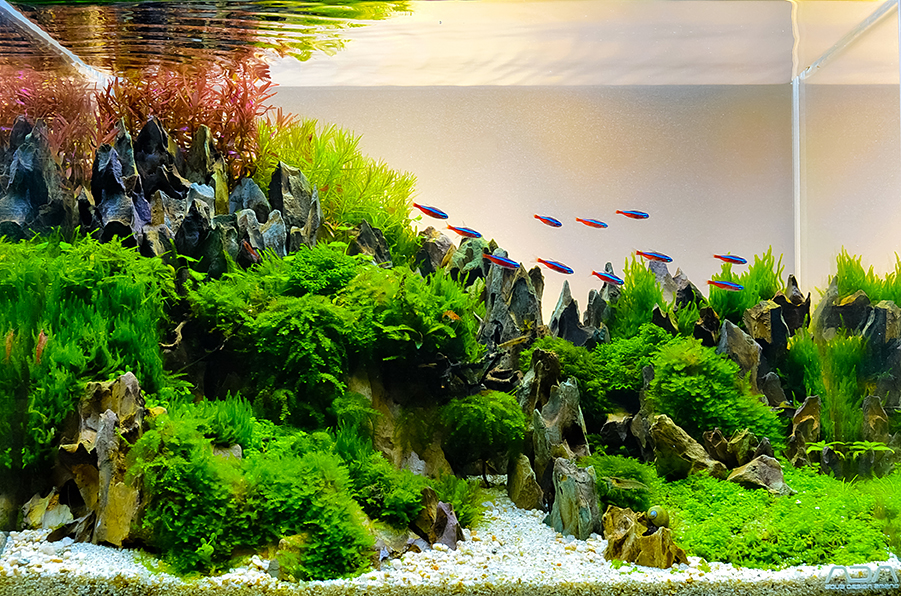Understanding Aquascaping
Aquascaping is the practice of arranging plants, rocks, caves, and wood in a manner that is aesthetically pleasing, as this Karina Lakefront blog explains. Aquascapes typically have some kind of fish too. If you’ve ever seen an aquarium that looked like a work of art, chances are that you’ve witnessed the magic of aquascaping first hand.
Initially, aquascaping often meant crafting aquatic environments inside an aquarium. Today, aquascaping can mean a wider landscape like a garden by a lake.
If you’re looking to get into the aquascaping hobby yourself, we’ve put together a simple aquascaping guide that will help you get started. Read on for our key tips and tricks.
Aquascaping Basics
Avoid Symmetrical Designs
Any good aquascaper will do their best to avoid symmetrical designs. This is because the goal of an aquascape is to look as natural as possible and, if we’re honest, nature is rarely symmetrical. Avoiding symmetry can help your aquascape look more professional and less like it’s been manmade.
A good way to keep things looking perfectly asymmetrical is to avoid using pairs and even numbered groups of decor. In addition, try to place the various elements of your design off center and not directly in the middle of your scene.
Practice the Rule of Thirds
The rule of thirds comes from the world of photography. It’s essentially a way of deciding which angle to take photos from to make the scene look more interesting but it works for aquascaping, too.
Basically, use your mind to create an imaginary grid. This grid should have two vertical lines and two horizontal lines, which will divide the tank into segments.
The focal points of your design will be placed along the lines or at positions where two lines meet, which helps you to avoid having too much symmetry and draws the eye to the most important parts of your setup.
Pick Your Focal Points
To create a successful aquascape, you’ll need to choose one or two focal points. These can be anything. For example, an awesome rock, a large piece of driftwood, a vibrantly colored plant, or a pathway made of different colored rocks.
Pay Attention to the Foreground, Midground, and Background
Deciding on a good place for plants and hardscapes is crucial. For example, if you place a really tall plant near the front of the lake, it’s going to block the view of anything behind it but, at the same time, a small plant in the background will go virtually unnoticed.
The point we’re trying to make here is that you need to pay attention to the sizes of the things that you’re placing in the foreground, midground, and background. Tall things should be in the back, medium-height things in the midground, and the shortest and smallest things in the front, the foreground.
The Principles of Aquascaping
Simplicity: Less is usually more when it comes to aquascaping. It can be tempting to incorporate a whole range of design elements but this practice is best avoided. It’s best to limit your design to a few select elements instead.
Variety: Keeping your design simple doesn’t have to mean using only one plant. You can maintain simplicity while using variety by choosing a theme and sticking to different elements within your theme.
Persistence is Key: Aquascaping can be frustrating and as such, persistence is key! Take your time and enjoy the learning curve but don’t give up.
Styles of Aquascaping: Three of the Most Popular Styles Today
Dutch
Dutch aquascaping is known for its extensive use of plants and foliage. Many times, it contains raised layers of plants – almost like terraces – which are known as “Dutch streets”.
Typically, Dutch aquascapes have carpeting plants covering the ground and a variety of midground and background plants of all shapes and sizes. The most notable part of these aquascapes is that there are almost never any pieces of hardscape. In other words, no driftwood or rocks are present.
Iwagumi
The Iwagumi aquascaping style focuses on minimalism and the use of open space. This style always includes a collection of rocks and stones, which have been carefully placed according to the Rule of Thirds.
This style consists of a large “Father” stone and a number of smaller stones. You can use any number of stones as long as the total number remains odd as well as one type of plant and a powder-like substrate such as fine rocks or sand. The father stone should always be the biggest thing in the setup.
Walstad
The Walstad style isn’t going to be the design that wins any serious awards. In fact, it’s most likely to be ignored by professionals but is still a very relevant style as it mimics the way a natural landscape would develop.
This means that it uses a completely random layout of plants and hardscape. There is no specific placement or rhyme or reason as to where things are placed in this setup.
maintenance. This style is low-budget and low-maintenance.
Conclusion
As you can see, aquascaping is a complex process that takes time and energy to master. This being said, though, the results are well worth it as you’re left with underwater works of art and tanks full of happy fish who appreciate your diligence.
Remember to keep it simple, utilize variety, and, as cliche as it sounds, keep trying! There’s nothing better than succeeding after overcoming a challenge.

